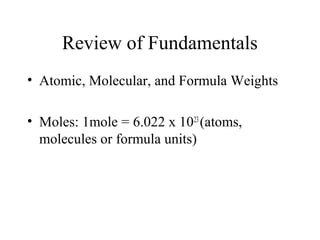
Stoichiometric Calculations
- 1. Review of Fundamentals • Atomic, Molecular, and Formula Weights • Moles: 1mole = 6.022 x 1023 (atoms, molecules or formula units)
- 2. How Do We Express Concentrations of Solutions? • Molarity (M)= moles/liter or mmoles/mL • Normality(N) = equivalence/liter or meq/mL • Formality(F)= is identical to molarity • Molality(m) = moles/1000g solvent
- 3. In normality calculations, the number of equivalents is the number of moles times the number of reacting units per molecule or atom. In normality calculations, the number of equivalents is the number of moles times the number of reacting units per molecule or atom. ©Gary Christian, Analytical Chemistry, 6th Ed. (Wiley)
- 4. Density Calculations How do we convert to Molarity • Density = mass solute /unit volume • Specific Gravity = Dsolute/DH20 • DH2O = 1.00000 g/mL @ 4o C • DH2O= 0.99821 g/mL @ 20o C
- 5. Analytical and Equilibrium Concentrations • They are not the same! • Analytical Molarity, Cx= sum of all species of the substance in solution • Equilibrium Molarity, [X] = concentration of a given dissolved form of the substance
- 6. Dilutions Preparing the Right Concentration • The millimoles taken for dilution will be the same as the millimoles in the diluted solution. • Mstockx mLstock = Mdilutedx mLdiluted
- 7. Expression of Analytical Results So Many Ways • Solid Samples: • %(wt/wt) = (wt analyte/wt sample)x 102 % • pt(wt/wt) = (wt analyte/wt sample)x 103 ppt • ppm(wt/wt) = (wt analyte/wt sample)x 106 ppm • ppb(wt/wt) = (wt analyte/wt sample)x 109 ppb
- 8. Expression of Analytical Results So Many Ways • Liquid Samples • %(wt/vol) = (wt analyte/vol sample mL)x 102 % • pt(wt/vol) = (wt analyte/vol sample mL)x 103 ppt • ppm(wt/vol) = (wt analyte/vol sample mL)x 106 ppm • ppb(wt/vol) = (wt analyte/vol sample,mL)x 109 ppb • Liquid Analyte • %(vol/vol) = (vol analyte/vol sample mL)x 102 % • pt(vol/vol) = (vol analyte/vol sample mL)x 103 ppt • ppm(vol/vol) = (vol analyte/vol sample mL)x 106 ppm • ppb(vol/vol) = (vol analyte/vol sample,mL)x 109 ppb
- 9. The units ppm or ppb are used to express trace concentrations. These are weigh or volume based, rather than mole based. The units ppm or ppb are used to express trace concentrations. These are weigh or volume based, rather than mole based. ©Gary Christian, Analytical Chemistry, 6th Ed. (Wiley)
- 10. The equivalents (based on charge) of cations and anions are equal.The equivalents (based on charge) of cations and anions are equal. ©Gary Christian, Analytical Chemistry, 6th Ed. (Wiley)
- 11. Reporting Concentrations as Different Chemical Species • We may express results in any form of the analyte. • Example: • Water Hardness due to calcium ion is expressed as ppm CaCO3. • Chloride present in AgCl derived from a salt mixture of NaCl and KCl.
- 12. Volumetric Analysis - Principles • “Titrimetry” – determination of analyte by reaction with measured amount of standard reagent • “Standard Solution” (titrant) – reagent of known concentration • “Titration” – slow addition of titrant to analyte solution from a volumetric vessel (buret) • “Equivalence Point” – reached when amount of added titrant is chemically equivalent to amount of analyte present in the sample. • “End Point” – the occurrence of an observable physical change indicating that the equivalence point is reached. Might differ from Eq.Pt.!
- 13. Volumetric Analysis - Principles How Do We Make Stoichiometric Calculations? • Titration- What are the requirements? 1. Reaction must be stoichiometric 2. Reaction should be rapid 3. No side reactions 4. Marked change in some property of the solution when reaction is complete 5. Equivalence point 6. Reaction should be quantitative
- 14. Volumetric Analysis - Principles Standard Solutions • “Primary Standard “ – – highly purified compound used as a reference material in titrimetry • Properties: • High purity • Stable in air • Independent of relative humidity • Readily available • Reasonable solubility • Large formula weight
- 15. Volumetric Analysis - Principles Standard Solutions • “Secondary Standard” – do not meet requirements for a primary standard but are available with sufficient purity and properties to be generally acceptable • Desirable properties of a Standard Solution: • Prepared from primary standard • Stable • Reacts rapidily and completely with analyte • Reacts selectively with analyte
- 16. Volumetric Analysis - Principles Examples of Standard Materials • Primary • Potassium Acid Phthalate • KHC8H4O4 (FW 204.23) • Benzoic Acid • C6H5COOH (FW 122.12) • Na2CO3, KH(IO3)2 • Arsenious Oxide (As2O3) • Sodium Oxalate (Na2C2O4) • KI , K2Cr2O7 , Fe(pure) • Secondary • NaOH , KOH , Ba(OH)2 • HCl , HNO3 , HClO4 • Sulfamic Acid (HSO3NH2) • KMnO4 , Na2S2O3 • Ce(HSO4)4 (FW 632.6)
- 17. Volumetric Analysis-Principles • Standardization – involves establishing the concentration of a “standard solution” • Direct method: • dissolve caarefully weighed quantity of primary standard; dilute to known volume • Indirect methods: • Titrate weighed quantity of primary standard • Titrate weighed quantity of secondary standard • Titrate measured volume of other standard solution
- 19. Volumetric Analysis - Principles • Acid – Base • HA + B BH+ + A- • Precipitation • Mn+ + X- MXn • Oxidation-Reduction • Red1 + Ox2Ox1 + Red2 • Complexation • Mn+ + Q M(Q)n+ use standard Q solution
- 20. Volumetric Analysis - Principles • Dilutions • Vcx Cc= Vdx Cd • Stoichiometric Ratios (S.R.) Mole Ratio: • What are stoichiometric ratios (mole ratios)? • 2 HCl + Ba(OH)2 2 HOH + Ba2+ + 2 Cl- • 2 MnO4 - + 5 C2O4 2- + 16 H+ 2Mn2+ + 10 CO2 + 8 HOH
